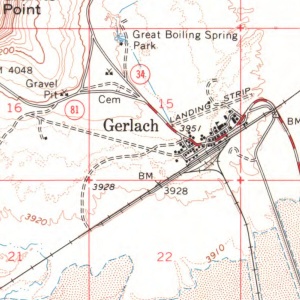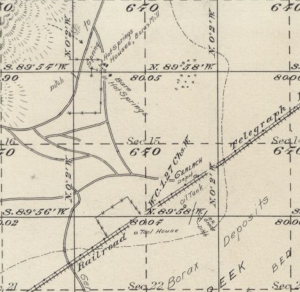Great Boiling Spring
The Gerlach Great Boiling Spring are located less than a mile west of Gerlach.
The name "Great Boiling Spring" comes from "'"Map of an Exploring Expedition to the Rocky Mountains in the Year 1842 - Oregon and Northern California in the years 1843-44,' Baltimore, MD: no publication date, no scale given. Litho by E. Weber & Co. Prepared by Brevet Capt. J.C. Fremont of the Corps of Topographical Engineers under the control of Col. J.J. Abert, Chief of the Topographical Bureau." (Citation from GNIS). See also Fremont's 1842 map (David Rumsey)
The name "Great Boiling Spring" also appears on Valley of the Mud Lakes (1855) from the 1854 expedition of Edward Griffin Beckwith.
- Alternative names:
- Boiling Springs: Bancroft's Map of California and Nevada: 1868, scale 1 inch=24 miles. H. H. Bancroft & Co., Booksellers & Stationers, San Francisco, Calif. Entered according to an act of Congress, A.D. 1868, by H. H. Bancroft & Company in the Clerk's Office of the District Court of the United States for the Northern District of California.
- Borax Hot Springs: Clason's Map of Nevada. Denver: Clason Map Company, 1916, scale 1 in=16 miles
- See Borax below.
- Gerlach Hot Springs: Carlson, Helen S., "Nevada Place Names, A Geographical Dictionary," Reno, Nevada: University of Nevada Press, 1974, 282 pp
- Mud Springs: Garside, L. J. and Schilling, J. H. "Thermal Waters of Nevada," Reno: Nevada Bureau of Mines and Geology Bulletin 91, 1979, 163 pp. Describes hot springs and hot water seeps of Nevada with location information and map at 1:1,000,000. map. (Mud Springs refers to the springs on the other size of Highway 447, see "Garside (1979) Aerial Photo," (archive.org)).
- Great Boiling Spring Park: Note that this is a historical name and that there is no public park
- Source: Gerlach (1964, Rp. 1977), Nevada 1:62,500 topographic quadrangles. (see thumbnail)
- GNIS. Citation: "U.S. Geological Survey. Geographic Names Phase I data compilation (1976-1981). 31-Dec-1981. Primarily from U.S. Geological Survey 1:24,000-scale topographic maps (or 1:25K, Puerto Rico 1:20K) and from U.S. Board on Geographic Names files. In some instances, from 1:62,500 scale or 1:250,000 scale maps." Date added: 12-Dec-1980

Borax
Garside states:"It has been reported that a borax works operated for a short time at Gerlach Hot Springs, but Papke (1976)[1] believes that this information is probably not true. There is not a large amount of boron in the spring water, and no borates can be found at the site."[2]
In 1896, the Weekly Nevada State Journal wrote: "Jim Raser, the Roop County borax king, arrived on the N-C-O last evening fat and jolly as ever".[3]
"Deposit of Borax found at Gerlach," The Reno Gazette Journal, October 27, 1909, p. 3 states that Borax was found at the Gerlach station while the turntable was being excavated.
The 1911 plat map for T32 R23 shows "Borax Mill" near the site of the Great Boiling Springs. Southwest of Gerlach appears the text "Borax Deposits".[4]

A 1912 reference states: "Hot Springs waters at Gerlach Washoe County Nev Borax plant established at one time"[5]
Another 1912 reference states: "Some other deposits of this type were operated in a small way at this time including a small plant established at the Hot Springs near the present site of the town of Gerlach, in Washoe County Nev., when this place was still some hundred miles more or less from its nearest railroad shipping point[6]
An April 29, 1912 newspaper article states that "Borax" in the water at Trego was the cause of a train engine boiler explosion that killed three people at Antelope.
The 1914-1915 WPRR Descriptive Time Table states: "The substantial station of Gerlach marks the time change from the Eastern to the Western Division of the Western Pacific Railway. The locality is noted for its group of warm hot springs and their battered adobe fort, at the base of the hills a mile and a half to the right. Amidst high sandstone ridges scored by wind and weather, through soda and borax flats imprinted with antelope tracks the train passes into the lava district of the Black Desert"[7]
In 1963, Sinclair found no Boron at Great Boiling Spring, but 4.5ppm was found at Coyote Spring and 2.8ppm was found at Black Rock Hot Spring.[8]
In 1965, Cromwell wrote that an unpublished memorandum by H.S. Gale states that in the 1890's (before the railroad) 3000 tons of Borax were shipped[9].
History
Hague and Emmons write about a 1867 visit as part of the Geological Exploration of the Fortieth Parallel: "About 3 miles southwest from Granite Creek Station, and near the southern end of the range, is a group of hot springs known as the Granite Creek Boiling or Mud Springs. Scattered over an area roughly estimated at 75 acres are a large number of pools, mostly circular, varying in size from 1 up to 25 feet in diameter, and surrounded by a luxuriant growth of brilliant green alkaline grasses, in marked contrast to the dull monotonous colors of the desert. The waters are clear and quite palatable when cool. The largest one visited had a temperature of 194° in the broad open pool; others indicated temperatures from 188° up to the boiling point, and yielded large volumes of vapor that could be seen many miles across the desert. Along with these springs are a number of mud springs, or, as they are called, "Mud Volcanoes", round basins from 2 to 3 feet below the surface of the ground and varying from 6 inches to 6 feet in diameter. These were filled with mud and slime, the contents being thrown up and violently agitated at regular intervals, accompanied by puffs of steam. Several of these springs had built up cones of hardened mud, and all, with one exception, closed at the top. In this one, the aperture was about 2 inches in width, and emitted a very perceptible odor of sulphuretted hydrogen; it is said occasionally to throw out mud and water in all directions for a distance of 100 yards. Fragments of this ejected material were found by analysis to have the composition of clay."[10]
The December 7, 1941 (Pearl Harbor Day) Nevada State Journal reports that Leslie E. Johnson transferred a deed to Charlie Wibel and H.J. Hughes for T32N, R23E, Sec. 10 and 15. Section 15 is Gerlach, Section 10 is north of Gerlach, so this could be the springs. Wibel also owned a gun club near Winnemucca Lake.
In 1973, Deborah Ann Brockelsby (age 19) from Lake Tahoe was scalded to death in one of the small pools (Reno Evening Gazette March 23, 1973, see also March 19 and 20). It was reported that she dove in to a hot pool after mistaking it for the cold pool. The pools were separated by a walkway. [11]
In "Assessment of Geothermal Resources of the United States (1975, USGS)", Gerlach was listed as having a surface temperature of 86C.
In 1983, owner John J. Casey stopped allowing public access after over a 10-year period, 5 visitors drown or were scalded to death.[12]
The residents raised $24,000 through donation, bake sales, raffles, dances, picnics and barbecues and built a 60 foot diameter pool with volunteer labor.
In 1986, the Washoe County Health Department red-tagged the pool because it was built without permits and approval by the health department. The health department stated that public bathing facilities need to have showers, toilets and a filtration system.
Nevada Bureau of Mines and Geology Gerlach Geothermal: "Great Boiling Springs were used extensively for bathing for many years ( figure). Some pools are too hot for swimming; a 19-year-old woman was scalded to death in one of these in 1973, an indication of the danger inherent in geothermal areas. The Gerlach General Improvement District built a bath house using geothermal fluids in 1989. The facility was planned for use by tourists and local residents. The facility has been unable to obtain a permit from the health department because of plugging of water filters by sediment from the well. No bathing facilities are available at the present (2002)."
Gerlach Green Energy and U.S. Geothermal hold geothermal leases near the springs.
References
- ↑ K. G. Papke, (1976) Evaporites and brines in Nevada playas: Nevada Bur. Mines and Geol. Bull. 87.
- ↑ L. J. Garside and J. H. Schilling, "Thermal Waters of Nevada," Reno: Nevada Bureau of Mines and Geology Bulletin 91, 163 pages, 1979.
- ↑ "Brevities," Weekly Nevada State Journal, p. 5, February 22, 1896.
- ↑ | Plat Maps for Range 23 East, Township 32, University of Nevada, Reno (host), Nevada Division of State Lands (owner)
- ↑ Mineral Resources of the United States, Part 2," p. 840-841, 1912.
- ↑ Minerals Yearbook," p. 858, 1912.
- ↑ "Descriptive Time Tables, Denver and Rio Grande - Western Pacific, Winter 1914-1915."
- ↑ William Sinclair, "Groundwater Appraisal of the Black Rock Desert Area Northwestern Nevada," October, 1963, Geological Survey.
- ↑ H. R. Cromwell, "B065: Mineral and water resources of Nevada," NV Bureau of Mines & Geology.
- ↑ Arnold Hague and S. F. Emmons, "Vol. II. Descriptive geology," p. 799, in Clarence King ed., "Report of the geological exploration of the fortieth parallel," 1877.
- ↑ Merced Sun-Star, March 19, 1973]
- ↑ Doug McMillan, "Gerlach residents have been waiting six years for a good hot soak," USA Today, July 28, 1989.
External Resources
- Gerlach Hot Springs Park (Wikipedia)
- GNIS Great Boiling Springs [http://geonames.usgs.gov/pls/gazpublic/getgooglemap?p_lat=40.6615681&p_longi=-119.3660202&fid=856518 Google Maps
- Donald E. White, "Violent mud-volcano eruption of Lake City hot springs, northeastern California", Geol. Soc. America Bull., v. 66, no.9, p.1109-1130, 1955. Mud volcanoes are mentioned near Gerlach "Great Boiling" Springs.
- L.J Garside and J.H. Schilling. 1979. "Thermal waters of Nevada." Nevada Bureau of Mines and Geology Bulletin 91. 1979
- Gerlach Geothermal (Nevada Bureau of Mines and Geology)
- University of Georgia Great Boiling Springs (Dead Link)
- Image of Gerlach Bath House (1994)
- Brian P. Hedlund Summer 2006 Nevada Hot Springs (Dead Link)
"The goals of this trip were to obtain high quality chemistry data, particularly redox active species, and samples for 16S rDNA clone library construction. The chemistry data will be used to model which chemolithotrophic metabolisms are most favorable in the bulk water at the sampling site and the clone libraries will allow us to see which microorganisms are present near the sediment/water interface at each site. We also helped Chuanlun Zhang with an experiment designed to enrich for microorganisms with chemolithotrophic activities of interest in situ."
- Nevada State Journal, "Gerlach News, March 14, 1926, p. 2. Meeting held at the courthouse to discuss "possible big improvements" to the hot springs.
- Nobles Trail (Emigrant Trails West) "Great Boiling Springs - Marker N-7"
- Robert Sanders, "Hot springs microbe yields record-breaking, heat-tolerant enzyme," 5-Jul-2011, UC Berkeley. A bacterium was found in the Gerlach Hot Springs that breaks down cellulose at temperatures near the boiling point of water. Image of the springs is included.
Images
- "Double Hot Springs boiling water. 0.8 miles north of Gerlach, Washoe County. 17 May 1946," UNRS-P1988-55-0736, J. A. Carpenter Collection, Special Collections Department, University of Nevada, Reno Libraries. Note that "Double Hot Springs" is actually elsewhere.
- WA-914, "Gerlach, 1964," Nevada Historical Society. View of the springs looking north east towards Old Razorback Mountain.
- WA-915, "Great Boiling Springs Park, Springs Discovered and named by John C. Fremont 1844. Park being developed by Gerlach-Empire Lions Club," 1964, Nevada Historical Society. Picture of the sign for the springs. Note that the plural, "Springs," is used, not the singular that is on the map.